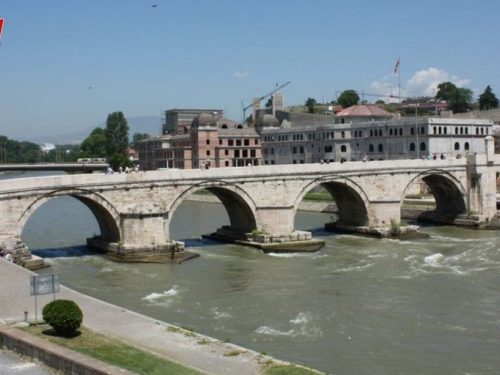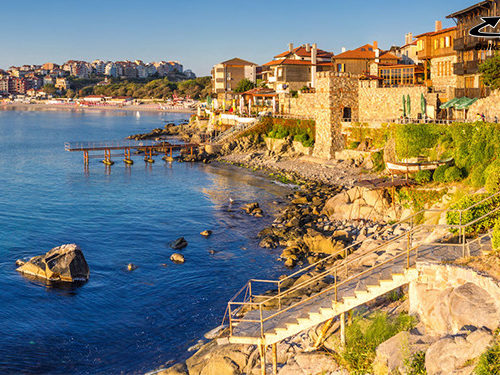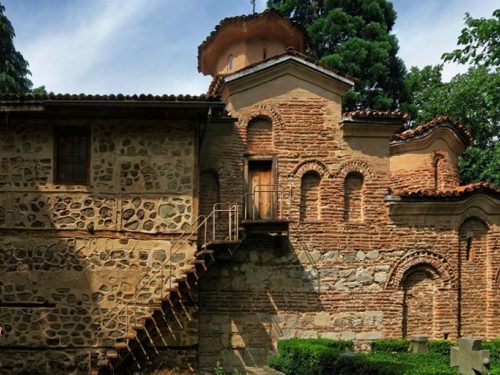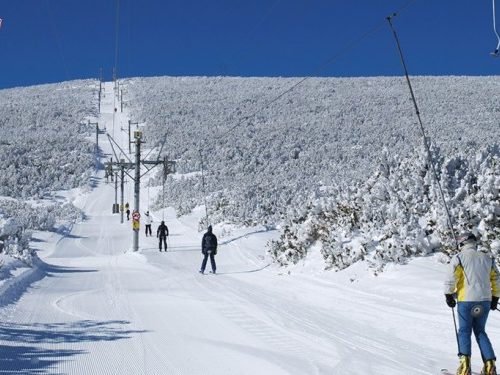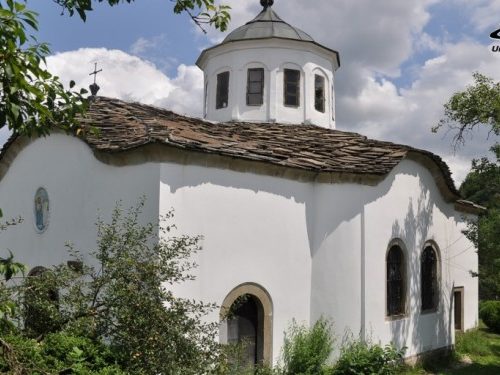Bulgaria is a country located in Southeastern Europe. It is bordered by Romania to the north, Serbia andMacedonia to the west, Greece and Turkey to the south, and the Black Sea to the east. Organised Prehistoric cultures began developing on Bulgarian lands during theNeolithic period. Its ancient history saw the presence of the Thracians, and later theGreeks and Romans. The emergence of a unified Bulgarian state dates back to the establishment of the First Bulgarian Empire in 681 CE, which dominated most of theBalkans and functioned as a cultural hub for Slavic peoples during the Middle Ages. With the downfall of the Second Bulgarian Empire in 1396, its territories came underOttoman rule for nearly five centuries. The Russo-Turkish War of 1877–1878 led to the formation of the Third Bulgarian State. The following years saw several conflicts with its neighbours, which prompted Bulgaria to align with Germany in both World Wars. In 1946 it became a single-party Socialist state as part of the Soviet-led Eastern Bloc. In1989 the ruling Communist Party allowed multi-party elections, which subsequently led to Bulgaria’s transition into a democracy and a market-based economy. The country’s current political structure dates to the adoption of a democratic constitution in 1991. Bulgaria is a unitary parliamentary republic with a high degree of political, administrative, and economic centralisation. It is a member of the European Union, NATO, and the Council of Europe; a founding state of the Organization for Security and Co-operation in Europe (OSCE); and has taken a seat at the UN Security Council three times.

Bulgaria
Prehistory and antiquity
Human activity in the lands of modern Bulgaria can be traced back to the Paleolithic. Animal bones incised with man-made markings from Kozarnika cave are assumed to be the earliest examples of symbolic behaviour in humans. Organised prehistoric societies in Bulgarian lands include the Neolithic Hamangia culture, Vinča culture and the eneolithic Varna culture (fifth millennium BC). The latter is credited with inventing gold working and exploitation. Some of these first gold smelters produced the coins, weapons and jewellery of the Varna Necropolis treasure, the oldest in the world with an approximate age of over 6,000 years. Thracians, one of the three primary ancestral groups of modern Bulgarians, began appearing in the region during the Iron Age. After the division of the Roman Empire in 5th century the area fell under Byzantine control. By this time, Christianity had already spread in the area. A small Gothic community in Nicopolis ad Istrum produced the first Germanic language book in the 4th century, the Wulfila Bible. The first Christian monastery in Europe was established around the same time by Saint Athanasius in central Bulgaria. From the 6th century the easternmost South Slavs gradually settled in the region, assimilating the Hellenised or Romanised Thracians.
First Bulgarian Empire
In the 7th century, Bulgar tribes, migrated to the lower courses of the rivers Danube,Dniester and Dniepr under the leadership of Asparukh. After 670 he moved into the Balkan Peninsula with a horde of 50,000 Bulgars across the Danube and in 680 severed Scythia Minor from the Byzantine Empire. A peace treaty with Byzantium in 681 and the establishment of a permanent capital at Pliska south of the Danube marked the beginning of the First Bulgarian Empire. The Bulgars gradually mixed up with the local population, adopting a common language on the basis of Slavonic. Wars with Croatians, Magyars, Pechenegs and Serbs and the spread of the Bogomil heresy weakened Bulgaria after Simeon’s death. Two consecutive Rus’ and Byzantine invasions resulted in the seizure of the capital Preslav by the Byzantine army in 971. Under Samuil, Bulgaria somewhat recovered from these attacks and managed to conquer Serbia and Albania, but this rise ended when Byzantine emperor Basil II defeated the Bulgarian army at Klyuch in 1014. Samuil died shortly after the battle, and by 1018 the Byzantines had ended the First Bulgarian Empire.
Following his death in 1391 however, Bosnia fell into a long period of decline. The Ottoman Empire had already started its conquest of Europe and posed a major threat to the Balkans throughout the first half of the 15th century. Finally, after decades of political and social instability, the Kingdom of Bosnia ceased to exist in 1463 after its conquest by the Ottoman empire.
Second Bulgarian Empire
After his conquest of Bulgaria, Basil II prevented revolts and discontent by retaining the rule of the local nobility and recognising the autocephaly of the Archbishopric of Ohrid. After his death Byzantine domestic policies changed and a series of unsuccessful rebellions broke out, the largest being led by Peter Delyan. In 1185 Asen dynasty nobles Ivan Asen Iand Peter IV organised a major uprising which resulted in the re-establishment of the Bulgarian state. Ivan Asen and Peter laid the foundations of the Second Bulgarian Empire with Tarnovo as a capital. The country’s military and economic might declined after the Asen dynasty ended in 1257, facing internal conflicts, constant Byzantine and Hungarian attacks and Mongol domination. By the late 14th century the Ottoman Turks had started their conquest of Bulgaria and had taken most towns and fortresses south of the Balkan mountains.
Ottoman rule
Tarnovo was captured by the Ottomans after a three-month siege in 1393. After the Battle of Nicopolis in 1396 brought about the fall of the Vidin Tsardom, the Ottomans conquered all Bulgarian lands south of the Danube. The nobility was eliminated and the peasantry wasenserfed to Ottoman masters, with much of the educated clergy fleeing to other countries. Under the Ottoman system, Christians were considered an inferior class of people. Thus, Bulgarians, like other Christians, were subjected to heavy taxes and a small portion of the Bulgarian populace experienced partial or complete Islamisation, and their culture was suppressed. Ottoman authorities established the Rum Millet, a religious administrative community which governed all Orthodox Christians regardless of their ethnicity. Most of the local population gradually lost its distinct national consciousness, identifying as Christians. However, the clergy remaining in some isolated monasteries kept it alive, and that helped it to survive as in some rural, remote areas, as well as in the militant Catholic community in the northwestern part of the country.
Third Bulgarian state
The Treaty of San Stefano was signed on 3 March 1878 by Russia and the Ottoman Empire, and included a provision to set up an autonomous Bulgarian principality roughly on the territories of the Second Bulgarian Empire. It never went into effect, as the Great Powers immediately rejected the treaty out of fear that such a large country in the Balkans might threaten their interests. It was superseded by the subsequent Treaty of Berlin, signed on 13 July, provided for a much smaller state comprising Moesia and the region of Sofia, leaving large populations of Bulgarians outside the new country. This played a significant role in forming Bulgaria’s militaristic approach to foreign affairs during the first half of the 20th century. The Bulgarian principality won a war against Serbia and incorporated the semi-autonomous Ottoman territory of Eastern Rumelia in 1885, proclaiming itself an independent state on 5 October 1908. In the years following independence, Bulgaria increasingly militarised and was often referred to as “the Balkan Prussia”. Between 1912 and 1918, Bulgaria became involved in three consecutive conflicts—two Balkan Wars and World War I. After a disastrous defeat in the Second Balkan War, Bulgaria again found itself fighting on the losing side as a result of its alliance with the Central Powers in World War I. The government ofBogdan Filov subsequently failed to achieve peace with the Allies. Bulgaria did not comply with Soviet demands to expel German forces from its territory, resulting in a declaration of war and an invasion by the USSR in September 1944. The Communist-dominatedFatherland Front took power, ended participation in the Axis and joined the Allied side until the war ended. The left-wing uprising of 9 September 1944 led to the abolition of monarchic rule, but it was not until 1946 that a single-party people’s republic was established. It became a part of the Soviet sphere of influence under the leadership of Georgi Dimitrov (1946–1949), who laid the foundations for a rapidly industrialising stalinist state which was also highly repressive with thousands of dissidents executed. Under the influence of the collapsing Eastern Bloc, on 10 November 1989 the Communist Party gave up its political monopoly, Zhivkov resigned, and Bulgaria embarked on a transition to a parliamentary democracy. The first free elections in June 1990 were won by theBulgarian Socialist Party (BSP, the freshly renamed Communist Party). A new constitution that provided for a relatively weak elected President and for a Prime Minister accountable to the legislature was adopted in July 1991. The new system initially failed to improve living standards or create economic growth—the average quality of life and economic performance remained lower than under Communism well into the early 2000s. A 1997 reform package restored economic growth, but living standards continued to suffer. After 2001 economic, political and geopolitical conditions improved greatly, and Bulgaria achieved high Human Development status. It became a member of NATO in 2004 and of the European Union in 2007.
Traditional Food
- Shopska Salad is the salad that defines Bulgaria. Not only is it the most popular Bulgarian salad but is also named after a big group of very frugal people called shopi who live in the capital of Bulgaria, Sofia. Shopska salad is made from chopped tomatoes, cucumbers, onions and peppers sprinkled with Bulgarian white cheese. Eat it with a chilled double rakia on the rocks.
- Shkembe Chorba – You probably don’t want to know exactly what this typically Bulgarian soup is made of. We suggest you first try it and see that it is actually pleasant to the taste. The literal English translation is tripe soup – tripe is the thick lining of the stomach of cattle… Seasoned with garlic, vinegar, and hot red pepper, it will surprise you with its unique aroma and taste – good surprise that is.
- Tarator is a cold soup made of yoghurt, cucumbers, and garlic. It is best enjoyed in the summertime when the blazing sun scorches your head. You can eat it any other time too but you will appreciate its icy chill more when the temperatures around you increase.
- Banitsa – This traditional Bulgarian pastry is first prepared by stacking up layers of filo pastry dough, mixture of whisked eggs, and pieces of Bulgarian cheese and then baked until it gets a golden crust.
- Lukanka is the Bulgarian cousin of the Italian sopresatta. In essence it is a spicy sausage made of minced meat curried with a lot of flavorful spices and half-dried in a cold, windy place for at least two months. In fact it is a must have on every table where rakia is served. Eat it with wine, beer, rakia, whiskey or any other drink you enjoy
- Kebapche – A meatball made of minced meat and spices and shaped like a sausage. Same as the kyufte, but does not contain onions. It has to be grilled otherwise you will get something different which probably will not be called kebapche (for comparison kyufte can also be fried). Eat it with Shopska salad and French fries with Bulgarian cheese.
- Kyufte – Again, a meatball made of minced meat and spices shaped like a meatball slapped with a spatula. Same as kebapche but contains chopped onions too. You can grill, fry or bake it. As with kebapche, eat it with Shopska salad and French fries with Bulgarian cheese.
- Meshana Skara consists of one kebapche, one kyufte, one pork steak and one skewer of pork meat. All this comes with French fries, bean salad with chopped onions and lyutenitsa. Eat with at least three beers and follow up with a rakia.
- Moussaka – One of the several Bulgarian foods confused in the West for being Greek. Moussaka is made with potatoes, ground meat, and tomatoes then it is topped with a white sauce and baked. Throw in some bay leaves too and you will not want to leave the table until you have finished up the entire baking pan. Eat this with some yoghurt on top
- Kavarma – This is one of the most popular meals in Bulgaria which is not so famous outside the country. The ingredients and preparations depend on the region. Almost every part of Bulgaria has it’s own Kavarma recipe. In general, the meal consists of marinated cooked meat and vegetables. It could be mild or spicy depending on the region and the likings.
- Sarmi – Another Bulgarian dish confused with its Greek cousin. Sarmi, or Dolmas, are made of grape or cabbage leaves stuffed with combination of rice and minced meat and then boiled. They can be served both hot or cold to you liking. Definitely try it with some yoghurt on top.
- Stuffed Peppers – Very very delicious meal – try it if you can. If you like Dolmas you are guaranteed to love this meal too. It’s pretty much what it says – green or red peppers stuffed with ground beef or pork and rice and boiled. Sometimes the peppers are topped with a seasoned tomato sauce or whisked eggs. Another variation of stuffed peppers is fried peppers stuffed with cheese and whisked eggs. Eat with lots of beer.
- Sirene – Bulgarian white cheese – a variety of the feta cheese but can be produced only in Bulgaria. This is due to a specific lactose tolerant bacteria which converts the milk into yoghurt and then sirene. The bacteria is found only in this part of the world, hence it name – Bacillus Bulgaricus. Bulgarian white cheese is a brined goat, sheep, or cow cheese and can be enjoyed as a side dish or as a part of many other Bulgarian meals. Eat it with some red pepper on top and with a glass of fine wine.
- Kiselo Mlyako – The Bulgarian yoghurt is the best yoghurt produced in the world. The only place where you can produce it and find it in its unaltered form is Bulgaria. This is due to the same Lactobacterium Bulgaricum that is used to make the Bulgarian cheese and which grows no place else in the world. If you are thinking of organic yoghurt – this is it in its purest form.
- Kashkaval – Kashkaval is the typical yellow cheese of Bulgaria. Very similar to the cheddar types of cheese, kashkaval is made of goat, sheep or cow’s milk. It is then aged for a certain period of time (about 6 months) to develop its very particular and defining flavor. Eat it as a side dish, appetizer, grind it over food, or have some with your Bulgarian wine.
- Lyutenitza is a sauce-like spread that is made from tomatoes, peppers, and eggplants pureed together. It looks a lot like babbaganush and has similar ingredients but it tastes a little more peppery. Lyut in Bulgarian means hot as in spicy, hence lyutenitsa. Although in truth, lyutenitsa is not really spicy
Traditional drinks
- Rakia is as rooted in Bulgarian history and existence as is bourbon in American. It has aided the nation in surviving its hardest years and has helped bring many bright ideas to live. In case you haven’t tried it yet, rakia is hard liquor from the brandy family.
- Boza – Increasingly popular across Europe and the world for its proved qualities for augmenting women’s breasts, boza is one of the most typical Bulgarian soft drinks. Well, since it had undergone some fermentation, it contains traces of alcohol but don’t worry, your stomach’s expansion limits will prevent you from getting drunk by its ~0.9% alcohol.
- Ayran – Made out of yogurt and water, ayran is the simplest drink you can prepare yourself besides, well, pouring yourself a glass water. Put some salt in it and you have in your hand a combination of the best cure for a hangover, a hot summer weather relief drink, a thirst quencher, and a nutritious smoothie.
- Mineral Water is huge in Bulgaria. Bulgaria is a country with many mineral springs scattered across the entire country. It’s cheaper to buy a bottle of mineral water than a bottle of regular purified water. It’s healthier too. The level of mineralization and the temperature of the mineral water differs across the country’s regions. Drink it from the bottle.
- Beer – Well, beer is beer. Not too much to say here. You probably would not believe if we say that most of the Bulgarian beer is equally good as its German or Belgian counterparts but go and try one – you will see what we mean. Oh, one thing: Bulgarian beer contains on average 10% alcohol, most of other beer stops at 5.5%. The most popular beers, in order of preference, are Kamenitza, Zagorka, Astika, Shumensko, Burgasko and Plevensko. Drink it with friends or with another beer.
- Wine – It is a universal truth that the Bulgarian wines are one of the best wines in the world. The unique technologies with which Bulgarian wines are produced date back to the ancient Thracians times. Bulgaria has almost perfect conditions for growing the best quality grapes. Its warm Mediterranean climate, combined with hilly terrains and good quality soils contribute for the country to be the second largest exporter of bottled wine in the world, second only to France.
Earth and Man Museum
The Earth and Man National Museum is amineralogical museum in the centre of Sofia, the capital of Bulgaria.
It’s one of the biggest mineralogical museums in the world. It was founded on 30 December 1985 and opened for visitors on 19 June 1987. The museum is situated in a reconstructed and adapted historic building
.
Archaeological Museum
The National Archaeological Museum is an archaeological museum in the centre of Sofia, the capital of Bulgaria. It occupies the building of the largest and oldest former Ottoman mosque in the city, Büyük camii (“Grand Mosque”), built around 1474 under Mehmed II. The museum was established as a separate entity in 1893 as the National Museum directed by Czech Václav Dobruský with its headquarters in the former mosque that previously housed the National Library between 1880 and 1893.
Art Gallery
The National Art Gallery is Bulgaria’s national gallery and houses over 50,000 pieces of Bulgarian art. It is located on Battenberg Square in the capital city of Sofia, occupying most of the historic and imposing edifice of the former royal palace of Bulgaria, having been established in 1934 and moved to the palace in 1946, after the abolition of the monarchy.
Gallery for Foreign Art
The National Gallery for Foreign Art of Bulgariais a gallery located on St. Alexander Nevsky Square in Sofia. It serves as the country’s national institution for non-Bulgarian art. It is situated in the 19th-century Neoclassic edifice of the former Royal Printing Office.
Historical Museum
The National Historical Museum in Sofia is Bulgaria’s largest museum. It was founded on 5 May 1973 and its first representative exposition was opened in 1984 to commemorate 1300 years of Bulgarian history. The museum was moved to a former governmental residence in 2000 and currently stores and owns over 650,000 objects connected to archaeology, fine arts, history and ethnography, although only 10% of them are permanently exhibited.
Museum of Military History
The National Military History Museum is a museum dedicated to military history in Sofia,Bulgaria. A structure of the Ministry of Defence, it has existed under various names and subordinate to various institutions since 1 August 1914 (in practice since 4 July 1916). It disposes of 5,000 m² of indoor and 40,000 m² outdoor (of which 500 m² covered) exhibition area, a library and a computer centre.
Museum of Natural History
The National Museum of Natural History of Bulgaria is a museum of natural history located in Sofia, the capital of the country on “Tzar Osvoboditel” str. next to the Russian church. Founded in 1889, it is affiliated with the Bulgarian Academy of Sciences, and is the first and largest museum of this kind in the Balkans.
Sofia Synagogue
The Sofia Synagogue is the largest synagogue in Southeastern Europe, one of two functioning inBulgaria (with the one in Plovdiv) and the third-largest in Europe.
Constructed for the needs of the Bulgarian capital Sofia’s mainly SephardicJewish community after a project by the Austrian architect Friedrich Grünanger, it resembles the old Moorish Leopoldstädter Tempel in Vienna and was officially opened on 9 September 1909 in the presence of Tsar Ferdinand I of Bulgaria.
.
Abritus
Abritus (Abrittus) was a late Roman city near the site of the modern city of Razgrad. Abritus was established at the end of the 1st century AD as a Roman military camp built on the ruins of an ancient Thracian settlement and grew to become one of the biggest urban centres in Moesia Inferior.
Thracian tomb of Aleksandrovo
The Aleksandrovo tomb is a Thracian burial mound andtomb excavated near Aleksandrovo, Haskovo Province, South-Eastern Bulgaria, dated to c. 4th century BCE.
On December 17, 2000 the tomb was accidentally uncovered by an earth-moving machine. Looters subsequently entered the tomb, damaging some of its frescoes. In 2001 Bulgarian archaeologist Georgi Kitov led a rescue excavation of the tomb, discovering a round chamber of about 3 meters (9.8 ft) in diameter, accessible through a small antechamber and a tunnel, approximately 6 meters (20 ft) long. Both the antechamber and main chamber are decorated with well-preserved frescoes that reflect the artist’s knowledge of Late Classical and Early Hellenistic art.
Beglik Tash
Beglik Tash is a Thracian rock sanctuary situated on the southern Black Sea coast ofBulgaria, a few kilometers north of the city of Primorsko.
Beglik Tash is a natural phenomenon of huge megaliths arranged and carved by a Thracian tribe and later used for religious ceremonies. It is part of a wider surrounding area and a natural rock formation of huge monolithic blocks of volcanic origin, and were formed of hardened magma that erupted from a volcano active during the Mesozoic era. Currently, an open-air museum is maintained by the Burgas Historical Society. Most of the megaliths have traces of carvings for the purposes of Thracian rituals.
Chevdar
Chevdar is a Neolithic archeological site near Kazanluk in Bulgaria. An early neolithic house was found that would have had wooden walls, marked by post holes. It was plastered with clay with the remains of a hearth also found. Carbonised seeds of emmer, barley andbitter vetch were found. ne o These results were found using one of the earliest uses of floatation technology in Archaeobotany.
Dausdava
Dausdava was a Dacian town in Moesia between the Danube and the Balkan Mountains, in the region between Nicopolis (modern Nikopol, Bulgaria) and Abritus (modern Razgrad).
Diocletianopolis
Diocletianopolis in Thracia was an ancient Roman town in the region of Thrace, nowadays the town of Hisaryain Bulgaria. It gained its official status as a city in 293 CE by the Roman emperor Diocletian.
Kozarnika
Kozarnika is a cave in northwestern Bulgaria that was used as a hunters’ shelter as early as the Lower Paleolithic (1,6 million BP). It marks an older route of early humans from Africa to Europe via the Balkans, prior to the currently suggested route across Gibraltar, and probably keeps the earliest evidence of human symbolic behaviour ever found. Here have been found the earliest European Gravette flintassemblages.
Madara
Madara is a village in northeastern Bulgaria, part of Shumen municipality, Shumen Province. Madara lies 15 kilometres (9.3 mi) east of the city of Shumen, at the western foot of the Madara plateau.
Novae
Archaeological site situated on the Danube in northern Bulgaria, about 4 kilometres east of the modern town Svishtov. A legionary base and late Roman town in the Roman province Moesia Inferior, later Moesia II.
Palace of Omurtag
The Palace of Omurtag or Aul is an archaeological site in northeastern Bulgaria dating to Late Antiquity and theEarly Middle Ages located near the village of Han Krum in Shumen Province. The site has been pinpointed as the location of a fort and palace of Omurtag, ruler (kanasybigi) of theFirst Bulgarian Empire in 815–831, as mentioned in the Chatalar Inscription of 822.
Perperikon
The ancient Thracian city of Perperikon is located in the Eastern Rhodopes, 15 km northeast of the present-day town of Kardzhali, Bulgaria, on a 470 m high rocky hill, which is thought to have been a sacred place. The village of Gorna Krepost (“Upper Fortress”) is located at the foot of the hill and the gold-bearing Perpereshka River flows near it.
Pistiros
Pistiros was an inland Ancient Greek Emporium in AncientThrace. It is now situated near city of Vetren, in the westernmost part of the Maritsa river valley.
Round Church
The Round Church is a large partially preserved early medieval Eastern Orthodox church. It lies in Preslav, the former capital of the First Bulgarian Empire, today a town in northeastern Bulgaria. The church dates to the early 10th century, the time of Tsar Simeon I’s rule, and was unearthed and first archaeologically examined in 1927–1928.
Sacred pit of Garlo
The Sacred pit of Garlo is an archaeological site located near the village of Garlo in Pernik District, Bulgaria. It was excavated in 1972 by Professor Dr. Dimitrina Mitova-Dzhonova and her team. Professor Dzhonova dates the pit around the 11th or 10th century BC and relates the site to the sacred pit built by the Nuragic civilization of Sardinia.
Seuthopolis
Seuthopolis was an ancient hellenistic-type city founded by the Thracian king Seuthes III, and the capital of the Odrysian kingdom. The city was founded sometime from 325 BC to 315 BC. It was a small city, built on the site of an earlier settlement, and its ruins are now located at the bottom of the Koprinka Reservoir near Kazanlak, Stara Zagora Province, in centralBulgaria. Seuthopolis was the only significant town in Thrace not built by Greeks, though it was built on an Ancient Greek plan.
Solnitsata
Solnitsata was an ancient town located in present-day Bulgaria, near the modern city of Provadia. Believed by Bulgarian archaeologists to be the oldest town in Europe, Solnitsata was the site of a saltproduction facility approximately six millennia ago. The settlement was walled to protect the salt, a crucial commodity in antiquity. Although its population has been estimated at only 350, archaeologist Vassil Nikolov argues that it meets established criteria as a prehistoric city.
Tatul
Tatul is a village inMomchilgrad municipality, Kardzhali Province located in the Eastern Rhodopes in southern Bulgaria. It is lies at 319 m above sea level at 41°33′N 25°33′E, 15 km east of Momchilgrad, and as of September 2005 has a population of 189 people. Most of the houses were built of well-cut stone blocks.
Thracian Rulers
The Valley of the Thracian Rulers is a popular name which was made public by the archaeologist Georgi Kitov and describes the extremely high concentration and variety of monuments of the Thracian culture in the Kazanlak Valley. It is believed that there are over 1500 funeral mounds in the region, with only 300 being researched so far.
Thracian Tomb of Kazanlak
The Thracian Tomb of Kazanlak is a vaulted brickwork “beehive” (tholos) tomb near the town of Kazanlak in central Bulgaria.
The tomb is part of a large Thracian necropolis. It comprises a narrow corridor and a round burial chamber, both decorated with murals representing a Thracian couple at a ritual funeral feast.
Thracian Tomb of Sveshtari
The Thracian Tomb of Sveshtari is situated 2.5 km southwest of the village of Sveshtari, Razgrad Province, which is located 42 km northeast of Razgrad, in the northeast of Bulgaria.
Varna Necropolis
The Varna Necropolis is a burial site in the western industrial zone of Varna (approximately half a kilometre from Lake Varnaand 4 km from the city centre), Bulgaria, internationally considered one of the key archaeological sites in world prehistory. The oldest golden treasure in the world, dating from 4,600 BC to 4,200 BC, was discovered at the site.
Central Balkan
The Central Balkan National Park lies in the heart of Bulgaria, nestled in the central and higher portions of the Balkan Range. The Park contains rare and endangered wildlife species and communities, self-regulating ecosystems of biological diversity, as well as historical sites of global cultural and scientific significance.
Pirin
Pirin National Park is a World Heritage national park that encompasses the larger part of the Pirin Mountains in the southwest of Bulgaria. It has an area of about 400 km2 (150 sq mi) and lies at an altitude from 1,008–2,914 m (3,307–9,560 ft).
Rila
Rila is a mountain range in southwesternBulgaria and the highest mountain range of Bulgaria and the Balkans, with its highest peak being Musala at 2,925 m. The massif is also the sixth highest mountain in Europe (when each mountain is represented by its highest peak only), coming after the Caucasus, the Alps, Sierra Nevada, the Pyrenees andMount Etna, and the highest between the Alps and the Caucasus. The larger part of the mountain is occupied by the Rila National Park.
Te tjera
- Belasitsa Nature Park
- Bulgarka Nature Park
- Golden Sands Nature Park
- Persina Nature Park
- Rilski Manastir Nature Park
- Rusenski Lom Nature Park
- Sinite Kamani Nature Park
- Shumensko Plato Nature Park
- Strandzha Nature Park
- Vitosha Nature Park
- Vrachanski Balkan Nature Park
- Srebarna Nature Reserve
- Silkosiya Reserve
- Burgas Lake Protected Area
- Atanasovo Lake Protected Area
- Mandra Lake Protected Area
- Poda Protected Area
- Usungeren Protected Area
- Chengene Skele Protected Area
- Strandzha Natural Park

